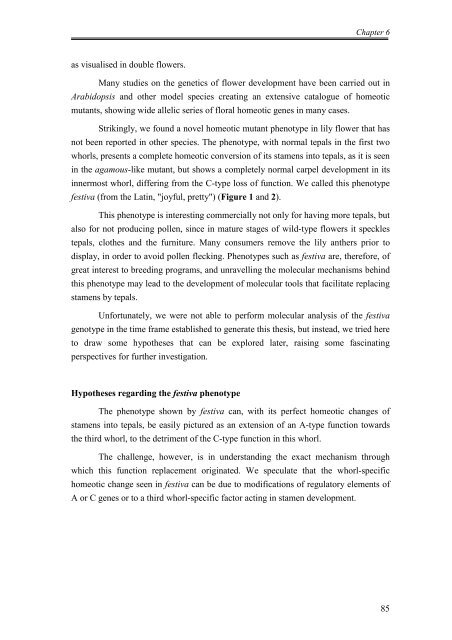Flower development of Lilium longiflorum - The Lilium information ...
Flower development of Lilium longiflorum - The Lilium information ...
Flower development of Lilium longiflorum - The Lilium information ...
Create successful ePaper yourself
Turn your PDF publications into a flip-book with our unique Google optimized e-Paper software.
as visualised in double flowers.<br />
Chapter 6<br />
Many studies on the genetics <strong>of</strong> flower <strong>development</strong> have been carried out in<br />
Arabidopsis and other model species creating an extensive catalogue <strong>of</strong> homeotic<br />
mutants, showing wide allelic series <strong>of</strong> floral homeotic genes in many cases.<br />
Strikingly, we found a novel homeotic mutant phenotype in lily flower that has<br />
not been reported in other species. <strong>The</strong> phenotype, with normal tepals in the first two<br />
whorls, presents a complete homeotic conversion <strong>of</strong> its stamens into tepals, as it is seen<br />
in the agamous-like mutant, but shows a completely normal carpel <strong>development</strong> in its<br />
innermost whorl, differing from the C-type loss <strong>of</strong> function. We called this phenotype<br />
festiva (from the Latin, "joyful, pretty") (Figure 1 and 2).<br />
This phenotype is interesting commercially not only for having more tepals, but<br />
also for not producing pollen, since in mature stages <strong>of</strong> wild-type flowers it speckles<br />
tepals, clothes and the furniture. Many consumers remove the lily anthers prior to<br />
display, in order to avoid pollen flecking. Phenotypes such as festiva are, therefore, <strong>of</strong><br />
great interest to breeding programs, and unravelling the molecular mechanisms behind<br />
this phenotype may lead to the <strong>development</strong> <strong>of</strong> molecular tools that facilitate replacing<br />
stamens by tepals.<br />
Unfortunately, we were not able to perform molecular analysis <strong>of</strong> the festiva<br />
genotype in the time frame established to generate this thesis, but instead, we tried here<br />
to draw some hypotheses that can be explored later, raising some fascinating<br />
perspectives for further investigation.<br />
Hypotheses regarding the festiva phenotype<br />
<strong>The</strong> phenotype shown by festiva can, with its perfect homeotic changes <strong>of</strong><br />
stamens into tepals, be easily pictured as an extension <strong>of</strong> an A-type function towards<br />
the third whorl, to the detriment <strong>of</strong> the C-type function in this whorl.<br />
<strong>The</strong> challenge, however, is in understanding the exact mechanism through<br />
which this function replacement originated. We speculate that the whorl-specific<br />
homeotic change seen in festiva can be due to modifications <strong>of</strong> regulatory elements <strong>of</strong><br />
A or C genes or to a third whorl-specific factor acting in stamen <strong>development</strong>.<br />
85














